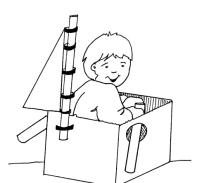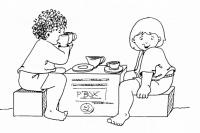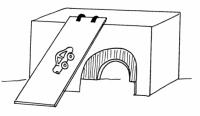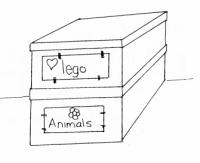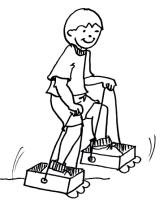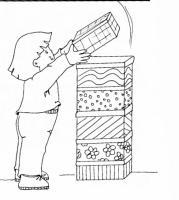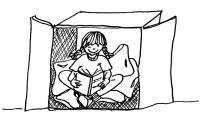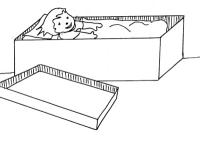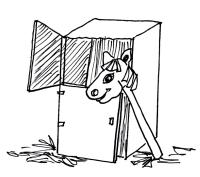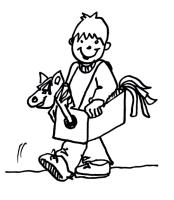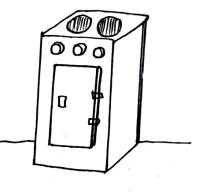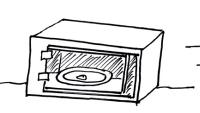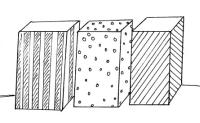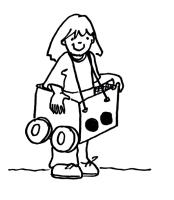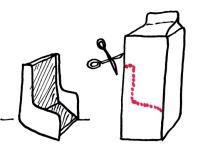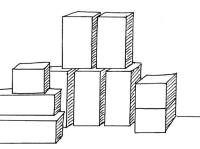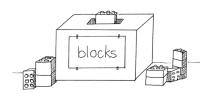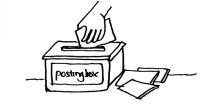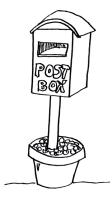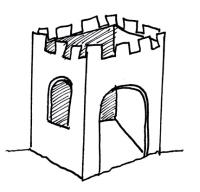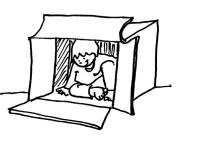Article 10 - Recycling cardboard boxes for children's play activities
|
We don't need expensive toys to engage the children's attention and imagination. You can use simple ordinary cardboard boxes to create the most amazing play items. Obtain small, very small, large and extra -large cardboard boxes from appliance retainers or supermarkets. Most retail outlet puts their boxes into recycling bins and are very happy to give them to you if you ask them. I have listed lots and lots of ideas for using cardboard boxes below.
Make a small rowing boat or sail boat by cutting small holes onto the sides of the box and insert cardboard cylinders (recycle the cylinders from used food wrap rolls) Securely attach another cylinder on the back and place a triangle of paper as the sail. The child sits in the boats and imagines they are rowing or sailing. Sing appropriate songs about boats, rowing, the sea or sailing, or simply allow the child to engage in imaginative play themselves.
The children can use a small cardboard box as a chair and a larger box as a table to have their tea party. Invite friends or the dolls and soft toy teddy bear can be guests as well for the imaginative play.
Make a garage for the toy cars by cutting a half circular hole at either end of a cardboard box. The cars can go through the tunnel openings into the garage. Securely attach a rectangular piece of cardboard down one side of the box as a car ramp. Use masking tape on the floor or carpet to mark out the road or draw it with chalk creating lots of fun and imagination.
Cover shoe boxes with coloured paper or contact, and use them as storage boxes for small toys or building blocks.
Thread thin rope into each side of the shoe boxes to act as the handles the children hold as they walk. Tie a knot at the end of the rope on the inside of the box so it doesn't slip out. Then place tape over the knot to secure it onto the inside of the box. You may choose to attach half circles of coloured cardboard at each front end of the shoe box. (Attach this cardboard underneath). The children put their feet inside each of the shoe boxes and walk using the thin rope to help lift their foot. They can then roar and stomp around the room pretending they are dinosaurs.
Cover a variety of sized boxes with coloured paper or contact. The children can use them to build and stack. Keep adding to the collection of boxes as you acquire them and you will have lots of activities for the children to do on a rainy day. You could also encourage the children to help you decorate them using paint, stickers, or cutting up and pasting recycled birthday or Christmas cards onto the boxes.
Place cushions inside a large cardboard box and the children can go inside to read or play with dolls, soft toys. Children enjoy compact places spaces to play in so this is ideal.
Place toys or dolls into shoe boxes or small boxes. Provide small pieces of fabric to fold and place them over the dolls as sheets, pillows and bedding.
Using an extra large cardboard box cut stable doors top and bottom. Place shredded paper inside and around the cardboard box stable. The children can imagine they feed and care for the play horse. Maybe they can draw colour in and cut out carrots and provide a small bowl for food and water. Turn an icecream carton upside down and wear on the head as a riding helmet for safety.
Cut a small hole at the front of the cardboard box to inset a cardboard cylinder. Attach the back of the cylinder with tape so it is attached securely to the back of the front side of the box. Make a horse head from a brown paper bag stuffed with recycled shopping bags or something light like shredded paper. Encourage the children to help you draw draw on the features of the horse on the paper bag. Securely attach the paper bag by tying an elastic band around the end of the bag and another elastic band to attach the paper bag to the cylinder. Make 2 holes at the front and back of the cardboard box and thread thin rope or ribbon to create the shoulder straps as shown in the illustration. Tie a knot at the end of the rope inside the box so it doesn't slip. Place thick tape over the knot so it is attached securely. The child places the straps over their shoulders and imagines they are driving the car. Encourage the children to help you make the car as that is an important part of the process.. The children can gallop around the room and imitate a horse neighing.
Using a stanley knife or scissors, cut a door for the oven. Paste on cut out cardboard for the hotplates and dials on the oven. Place this in a sandpit or home corner for the children to use too cook the sand cake or play food.
Using a stanley knife or scissors, cut a door for the microwave. Paste on cut out cardboard for the dials on the side of the microwave oven. Place a paper plate inside the microwave and the children can pretend to cook meals or food in the home corner or pizza shop.
Cover washed cleaned milk cartons or cardboard boxes with coloured paper. Line them up on the floor and roll or throw a ball at them.
Encourage the children to create their own designs and constructions using cardboard boxes and tape. Provide a big basket or container full of a variety of sized cardboard boxes the children can select from, Also provide scissors and masking tape (or similar). Allow this to be the child's work even if it's not perfect because it is the process and experience that is the learning is all about in early childhood...not the finished perfect product!
Make 2 holes at the front and back of the cardboard box and thread thin rope or ribbon to create the shoulder straps as shown in the illustration. Tie a knot at the end of the rope inside the box so it doesn't slip. Place thick tape over the knot so it is attached securely. Add cut out coloured paper for the lights and paper plates become the wheels. The child places the straps over their shoulders and imagines they are driving the car. Encourage the children to help you make the car as that is an important part of the process.
Place a series of different sized boxes the children can crawl through as tunnels. Great for a rainy day!
Cut doll's furniture from clean empty milk cartons. Cut around the red dotted lines shown on the illustration and place a small folded piece of fabric for the cushion to sit on. You can also make tables! Just be brave to be creative and use your imagination!
Cover a variety of boxes with contact or coloured paper. Contact is ideal for long term use. The children can spend hours stacking and building with the boxes of varying sizes.
Cut a hole in the lid of a shoe box and use it to post card, small blocks, Lego or letters the children write.
Cut a slit into the side of a medium sized cardboard box. Paint the box red and put a sign on it that it is the POST BOX. Place a piece of cardboard over the top as shown in the illustration to give the Post box character. It doesn't matter if you choose not to do this. Place the box on a table top with envelopes, pens, stamp pads and stamps and paper so the children can draw or write letters ( not that they will be able to write properly at an early childhood stage). You may also choose to attach the Post Box to a large cardboard cylinder in a pot plant filled with sand to keep it stable.
Turn the box upside down so the top is now forming a base at the bottom.Using a stanley knife or a pair of scissors cut a door and windows in a large cardboard box. A box that stored a refrigerator or washing machine is ideal. Cut the square shapes at the top of the box to represent the turrets of a castle. Place cushions or a blanket inside and the children can use it a s quiet reading area.
Place several cardboard boxes behind a small children's chair. Then place toy teddy bears and dolls into the cardboard boxes as the passengers in the bus or train carriages. Use a paper plate to imitate the steering wheel.
The children love playing hide and seek so if you provide a variety of boxes they can climb into and re arrange it can provide hours of make believe fun. |

